Auto Sweptback Wing Based on Low Scattering Demand for an Unmanned Aerial Vehicle in Phase Flight
Abstract
1. Introduction
2. Auto Swept Scheme
2.1. Auto Sweep Target
2.2. Sweep Angle Determination
2.3. Electromagnetic Scattering Evaluation
3. Model
4. Results and Discussion
4.1. Preliminary Analysis
4.2. Results Obtained by FAM
4.3. Auto Sweep Angle
4.4. Comparison of Optimal Solutions
5. Conclusions
- (1)
- This aircraft had a low electromagnetic scattering level, and its average RCS slowly increased with the increase in the radar wave frequency in the given range. The average RCS of the wing in the phase flight slowly increased with the increase in the elevation angle within the given range.
- (2)
- When the observation plane was horizontal and the terminal azimuth was 90°, increasing the initial azimuth did not change the optimal sweepback angle of the aircraft under the given conditions, while when the observation initial azimuth angle was 90°, the increase in the elevation angle affected the optimal sweepback angle of the aircraft under the given conditions.
- (3)
- The auto sweep scheme could effectively capture the minimum sweepback angle of the aircraft in the phase flight while reducing the mean and some minima of the aircraft RCS indicator curve, thus making the aircraft show a lower electromagnetic scattering level under different observation conditions.
Author Contributions
Funding
Institutional Review Board Statement
Informed Consent Statement
Data Availability Statement
Acknowledgments
Conflicts of Interest
Appendix A. Comparison of Search Results
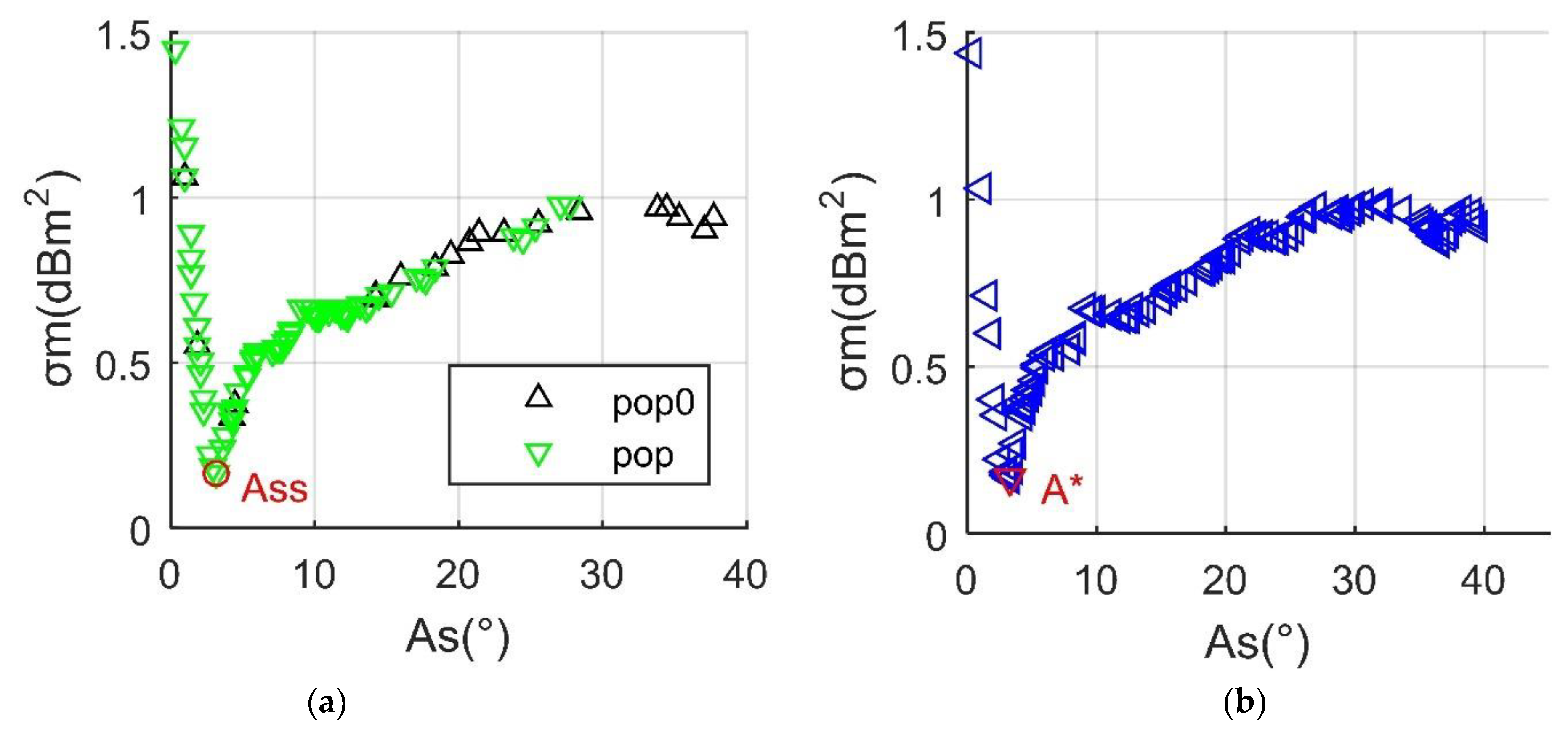
References
- Dong, Y.; Chen, Y.; Peng, J. Development and prospect of variable swept wing. Flight Dyn. 2014, 32, 97–100. [Google Scholar]
- Pisanu, T.; Muntoni, G.; Schirru, L.; Ortu, P.; Urru, E.; Montisci, G. Recent Advances of the BIRALET System about Space Debris Detection. Aerospace 2021, 8, 86. [Google Scholar] [CrossRef]
- Cai, Z.; Gao, Z. Design of a variable sweep wing driving mechanism and CFD simulation. J. Mach. Des. 2018, 35, 17–22. [Google Scholar]
- Abdalla, A.M.; Baraky, F.C.; Urzedo Quirino, M. Conceptual design analysis of a variable swept half-span wing of a supersonic business jet. CEAS Aeronaut. J. 2020, 11, 885–895. [Google Scholar] [CrossRef]
- Sun, R.; Zhao, R.; Shi, J. Dynamic Characteristic Analysis for Missile with Variable Sweep Wings. Aero Weapon 2013, 1, 8–11. [Google Scholar]
- Ibren, M.; Sulaeman, E.; Legowo, A.; Abdullah, N.A. Roll Control Reversal of Variable Swept Wing in Supersonic Flow. Int. J. Recent Technol. Eng. 2019, 7, 288–291. [Google Scholar]
- Du, X.; Liu, X.; Dong, Y.; Wang, H.; He, T.; Wang, C. Design and Dimensional Synthesis of Variable Swept-wing Linkage Driving Mechanism. J. Beijing Univ. Aeronaut. Astronaut. 2021, 35, 220–246. [Google Scholar] [CrossRef]
- Teber, A.; Cil, K.; Yilmaz, T.; Eraslan, B.; Uysal, D.; Surucu, G.; Baykal, A.H.; Bansal, R. Manganese and Zinc Spinel Ferrites Blended with Multi-Walled Carbon Nanotubes as Microwave Absorbing Materials. Aerospace 2017, 4, 2. [Google Scholar] [CrossRef]
- Lv, J.; Dong, Y.; Chen, Y. Rules of the optimal variable sweep wing in low and medium height. Flight Dyn. 2016, 34, 24–27. [Google Scholar]
- Ma, T.; Fan, Y.; Chang, N.; Yang, J.; Yu, Z.; Zhou, X. Design of a variable-sweep wing structure with flexible shear skin. Aerosp. Syst. 2022, 5, 37–46. [Google Scholar] [CrossRef]
- Liang, H.S. Stealth technology for radar onboard next generation fighter. Mod. Radar 2018, 40, 11–14. [Google Scholar]
- Zhou, Z.; Huang, J. Z-folding aircraft electromagnetic scattering analysis based on hybrid grid matrix transformation. Sci. Rep. 2022, 12, 4452. [Google Scholar] [CrossRef] [PubMed]
- Pan, F. Study on The Measurement of Near-Field Backscatter in Changeable Wing Aircraft Model. Aerosp. Shanghai 1998, 1, 43–47. [Google Scholar]
- Delgado-Aguilera Jurado, R.; Gómez Comendador, V.F.; Zamarreño Suárez, M.; Pérez Moreno, F.; Verdonk Gallego, C.E.; Arnaldo Valdés, R.M. Assessment of Potential Conflict Detection by the ATCo. Aerospace 2022, 9, 522. [Google Scholar] [CrossRef]
- Ye, S.B.; Xiong, J.J. Dynamic RCS Behavior of Helicopter Rotating Blades. Acta Aeronaut. Astronaut. Sin. 2006, 27, 816–822. [Google Scholar]
- Zhou, Z.; Huang, J.; Yi, M.; Zhong, G. Optimization plug mode of external fuel and weapons for less changing aircraft center of gravity. Math. Probl. Eng. 2017, 2017, 1409829. [Google Scholar] [CrossRef]
- Xu, X.; Gong, S.X. The forward-backward IPO algorithm for calculating open-ended cavities. Space Electron. Technol. 2008, 1, 72–76. [Google Scholar]
- Zhou, Z.; Huang, J. Mixed design of radar/infrared stealth for advanced fighter intake and exhaust system. Aerosp. Sci. Technol. 2021, 110, 106490. [Google Scholar] [CrossRef]
- Su, F. 3D Path Planning of UAVs Based on Improved Bat Algorithm. Radio Engineering. 2022. Available online: https://kns.cnki.net/kcms/detail/13.1097.TN.20221028.0954.010.html (accessed on 28 October 2022).
- Zhou, Z.; Huang, J. Numerical investigations on radar cross-section of helicopter rotor with varying blade pitch. Aerosp. Sci. Technol. 2022, 123, 107452. [Google Scholar] [CrossRef]
- Higasa, K.; Itoh, E. Controlling Aircraft Inter-Arrival Time to Reduce Arrival Traffic Delay via a Queue-Based Integer Programming Approach. Aerospace 2022, 9, 663. [Google Scholar] [CrossRef]
- Yang, Q.; Deng, M.; Peng, Y. Urban UAV Path Planning Based on improved Beetle search algorithm. J. Syst. Simul. 2022, 8, 192760–192776. [Google Scholar] [CrossRef]
- Li, Y.; Lyu, Y.; Shi, J.; Li, W. Autonomous Maneuver Decision of Air Combat Based on Simulated Operation Command and FRV-DDPG Algorithm. Aerospace 2022, 9, 658. [Google Scholar] [CrossRef]
- Zhang, Y.; Song, W.; Song, B.; Zhang, W. Research on wing structure deformation for aerodynamic force and inertial force of flapping-wing. J. Aerosp. Power 2010, 25, 1561–1566. [Google Scholar]
- Shen, H.; Yu, Y. Development and key technologies of morphological bionic aircraft. Adv. Aeronaut. Sci. Eng. 2021, 12, 9–19. [Google Scholar]
- Wang, Q.; Zhang, X.; Yan, X.; Wang, F.; Cheng, T. Design of a Surface Plasmon Resonance Temperature Sensor with Multi-Wavebands Based on Conjoined-Tubular Anti-Resonance Fiber. Photonics 2021, 8, 231. [Google Scholar] [CrossRef]
- Bluman, J.E.; Pohly, J.A.; Sridhar, M.K.; Kang, C.K.; Landrum, D.B.; Fahimi, F.; Aono, H. Achieving bioinspired flapping wing hovering flight solutions on Mars via wing scaling. Bioinspiration Biomim. 2018, 13, 046010. [Google Scholar] [CrossRef]
- Wang, X.Y.; Dallmann, T.; Moch, R.; Heberling, D. ISAR tomography for full-polarimetric 3-D radar cross-section measurements. IEEE Trans. Antennas Propag. 2019, 67, 2853–2858. [Google Scholar] [CrossRef]
- Fu, Y.; Zhao, S. Design of the aircraft model for bionic dragonflies’ flapping wings and analysis on the aerodynamic characteristics. J. Mach. Des. 2021, 38, 79–87. [Google Scholar]
- Wang, C.; Li, Y.; Feng, M.; Wang, J.; Ma, H.; Zhang, J.; Qu, S. Frequency-selective structure with transmission and scattering deflection based on spoof surface plasmon polariton modes. IEEE Trans. Antennas Propag. 2019, 67, 6508–6514. [Google Scholar] [CrossRef]
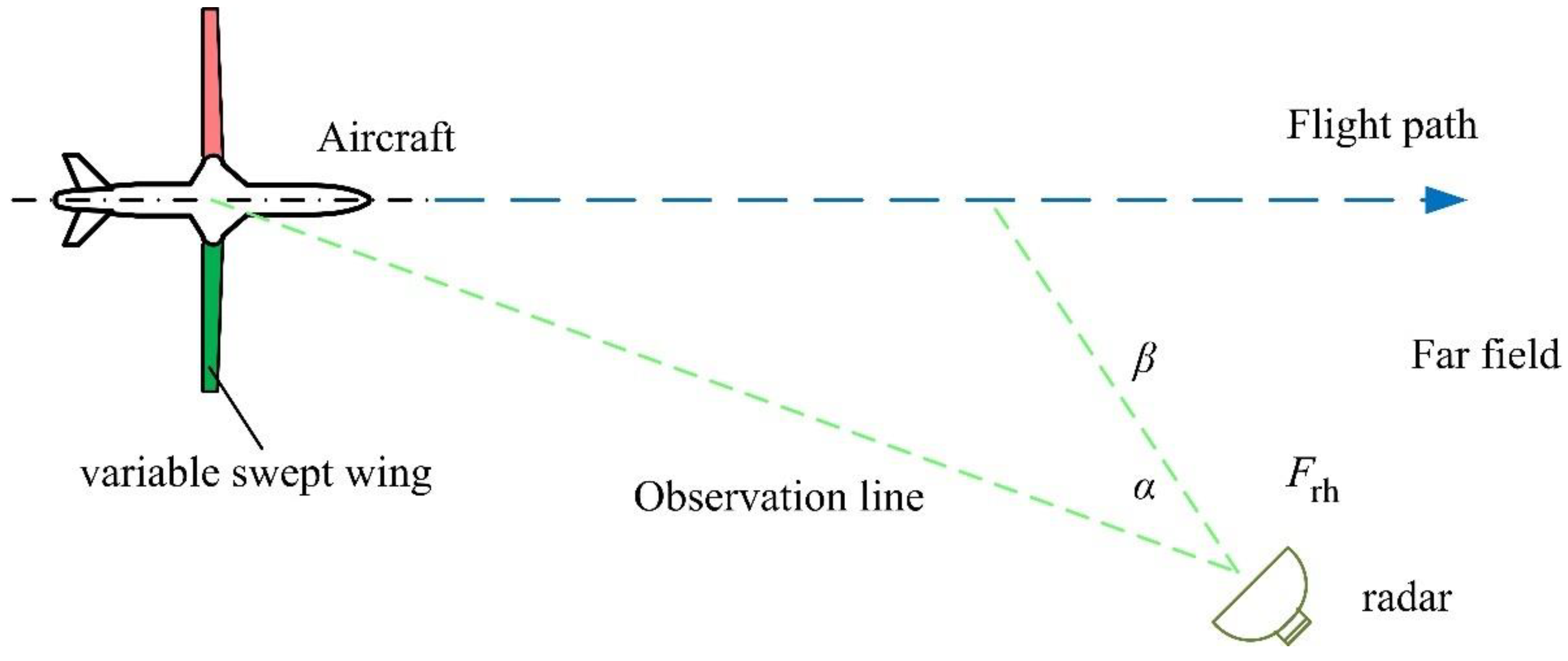




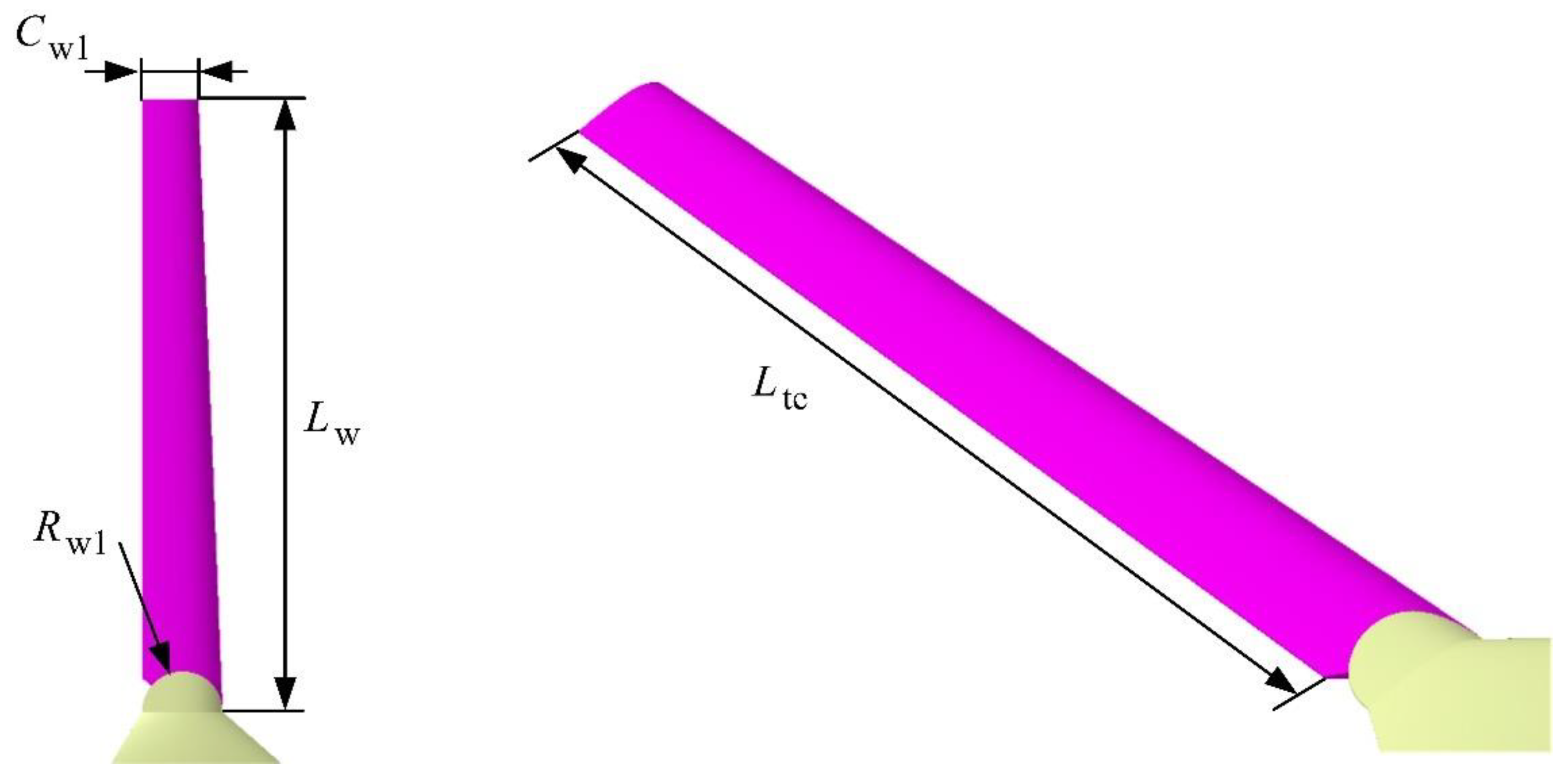
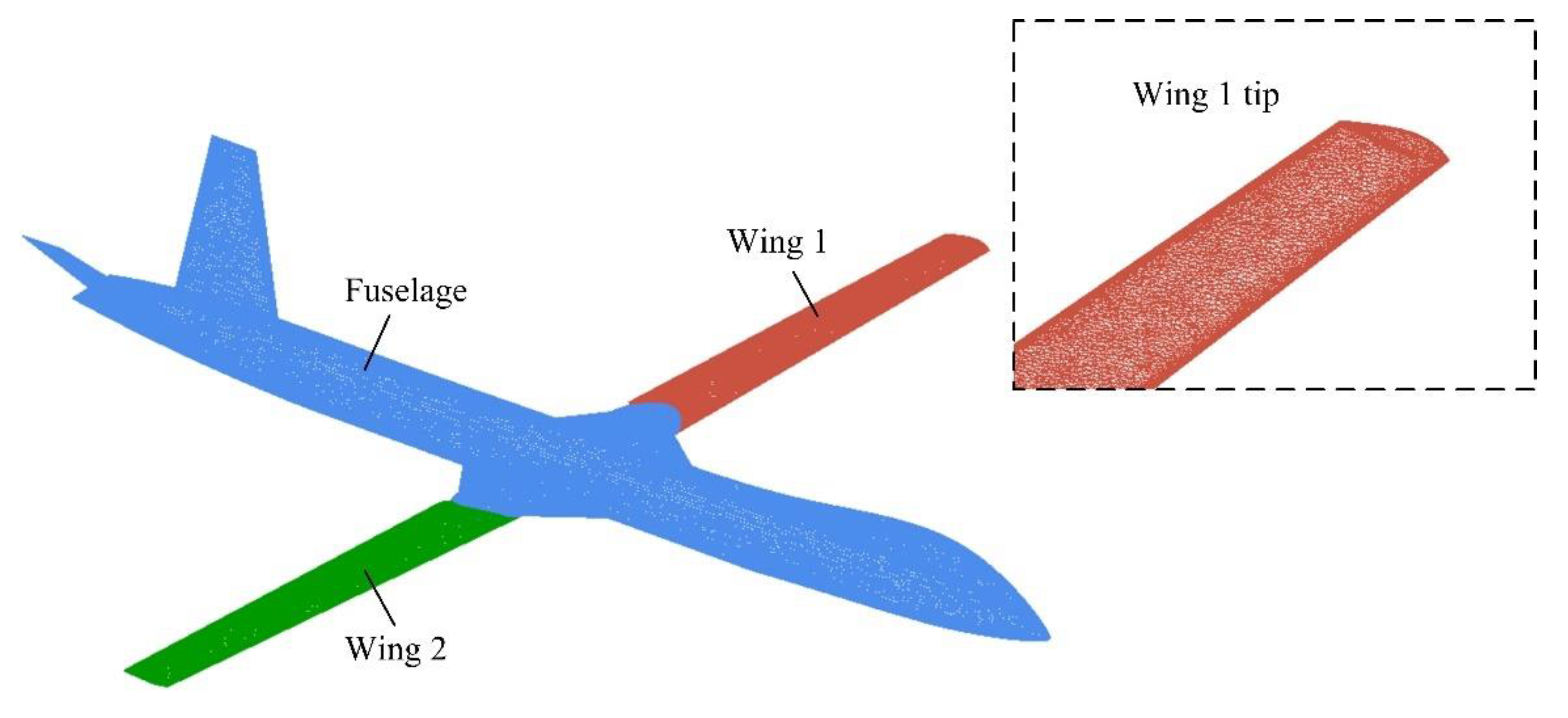


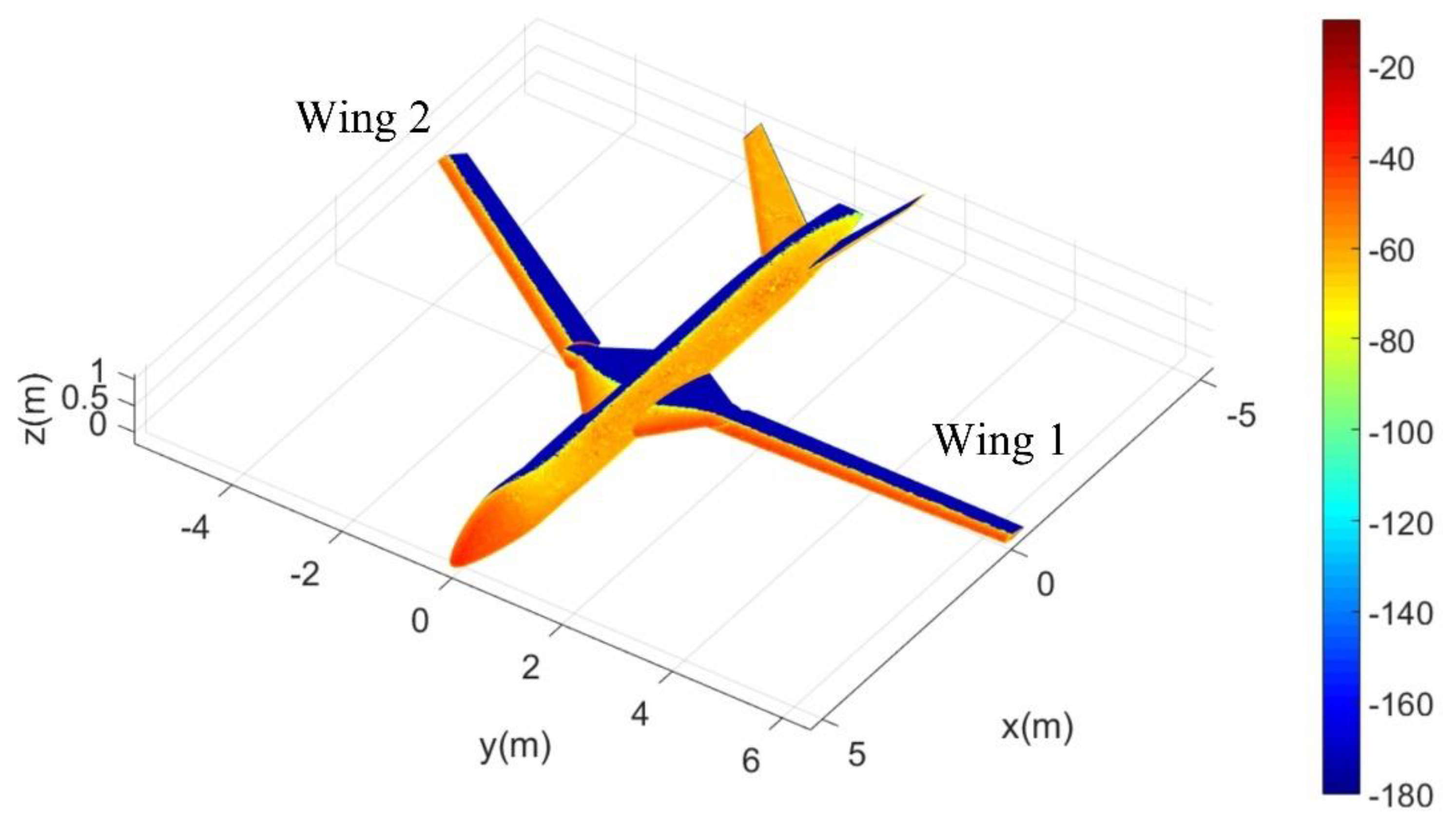

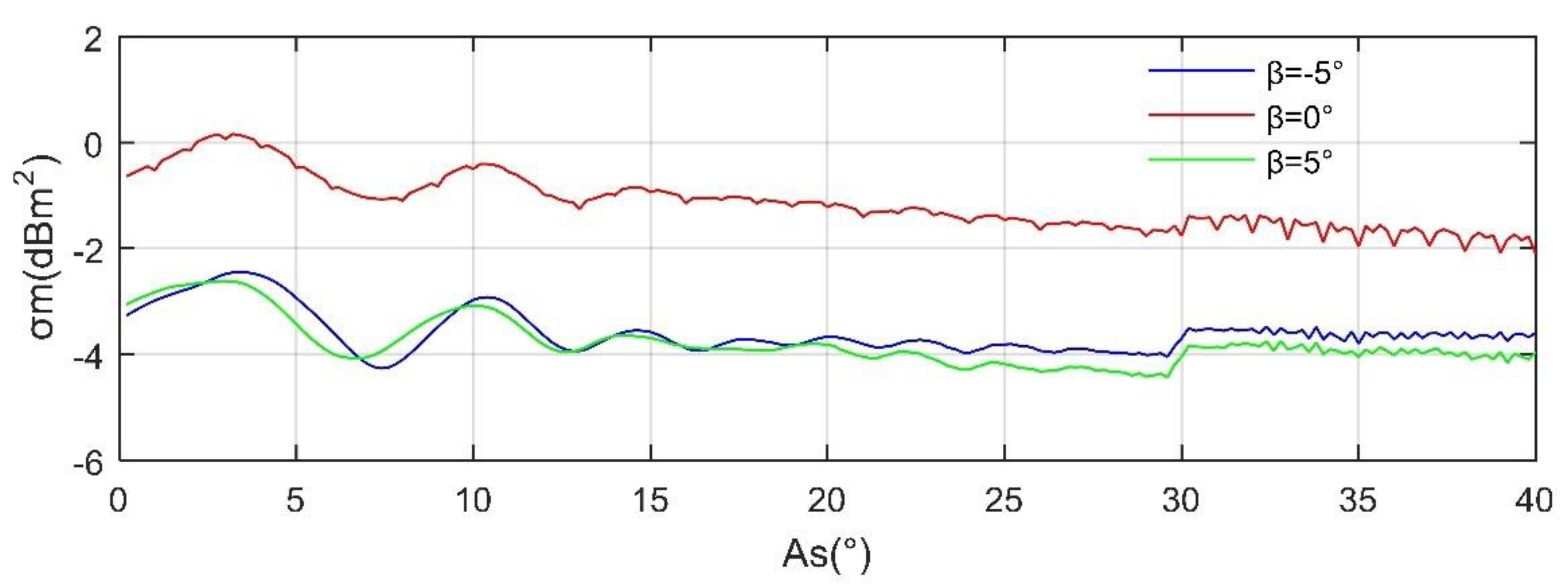
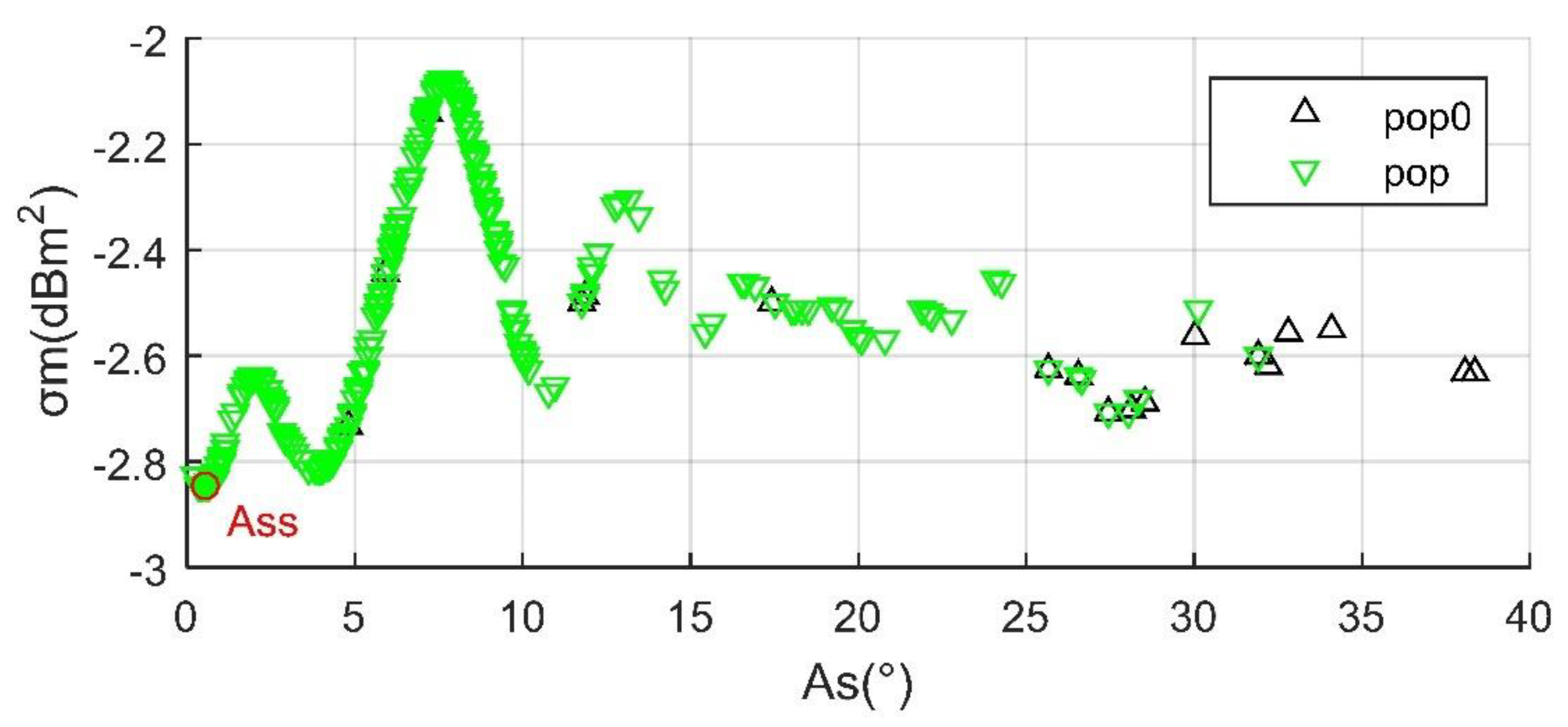
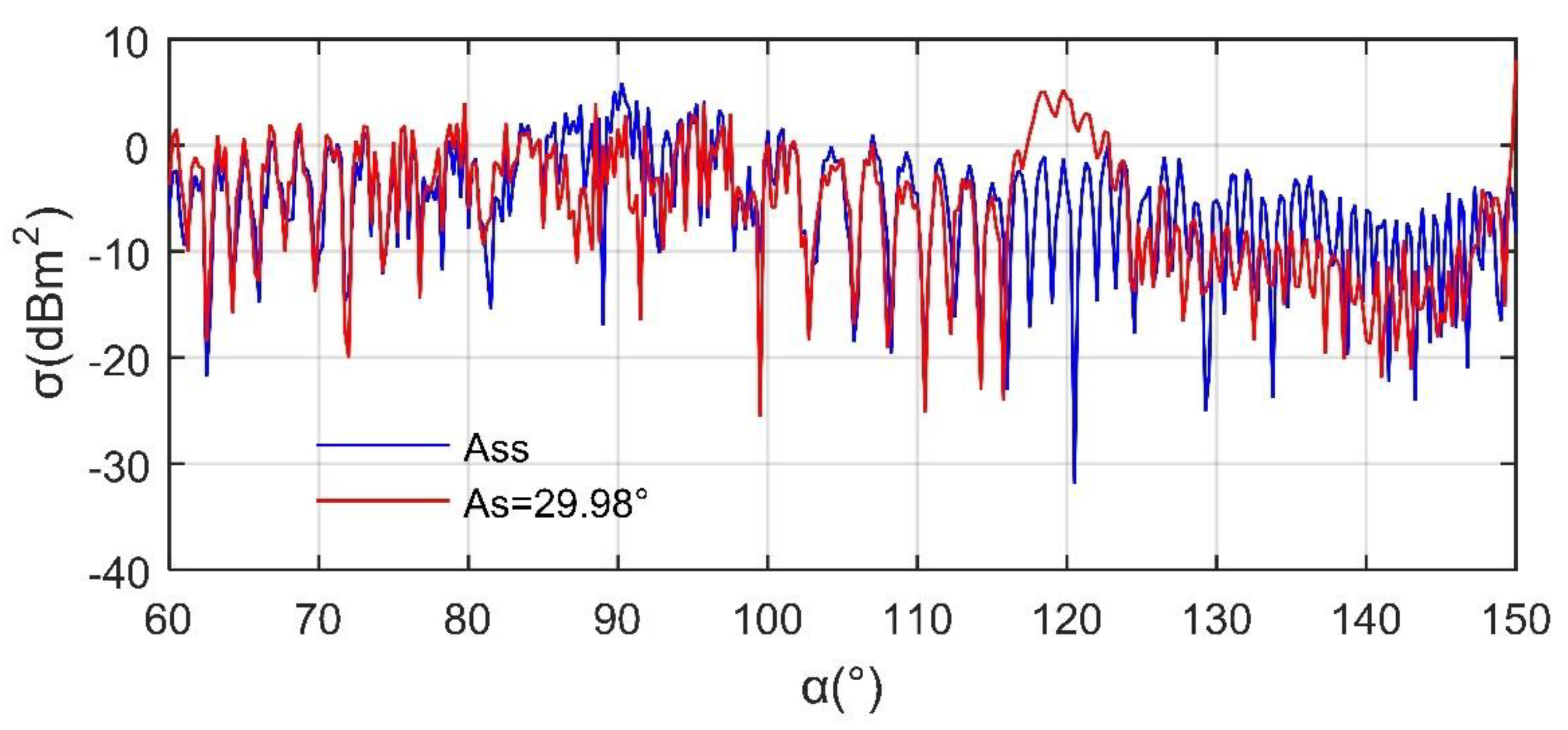

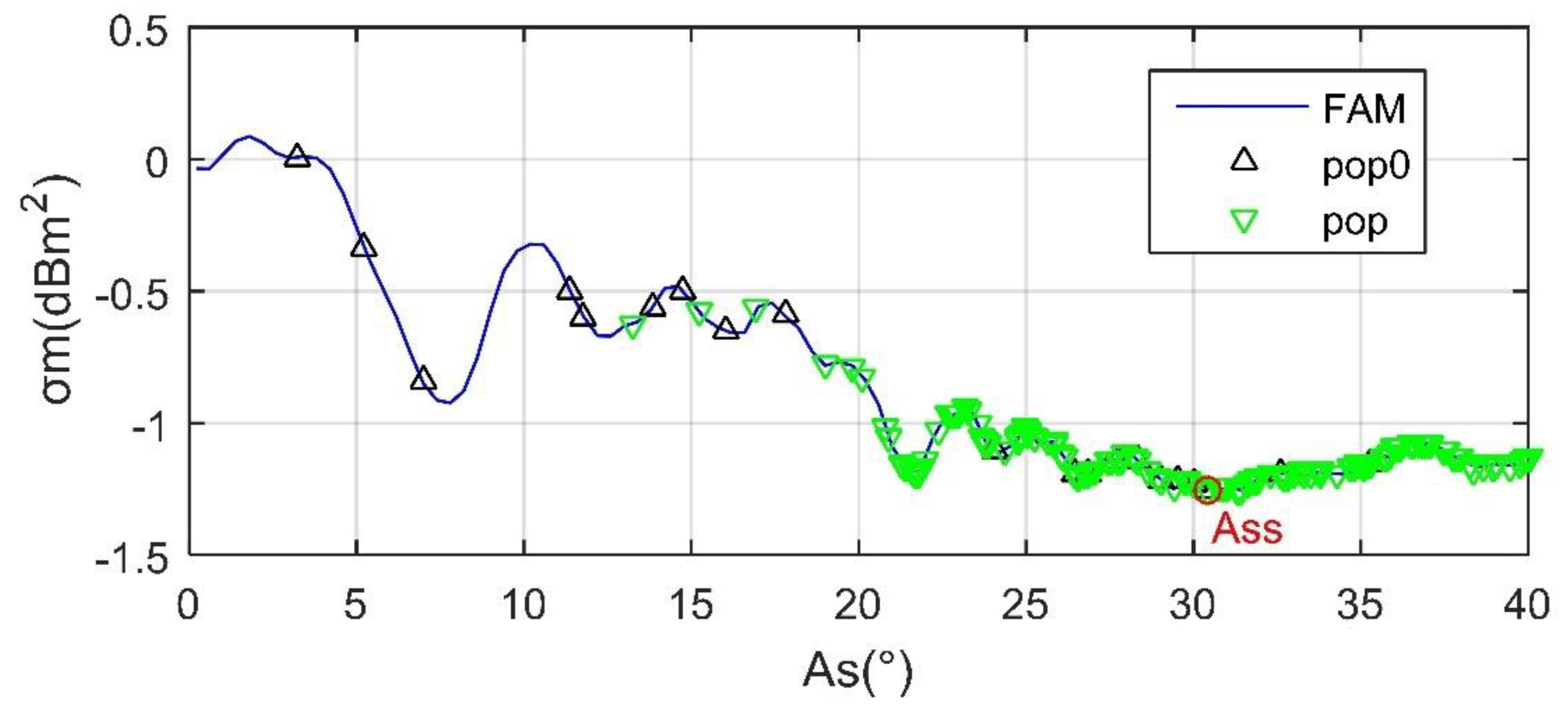
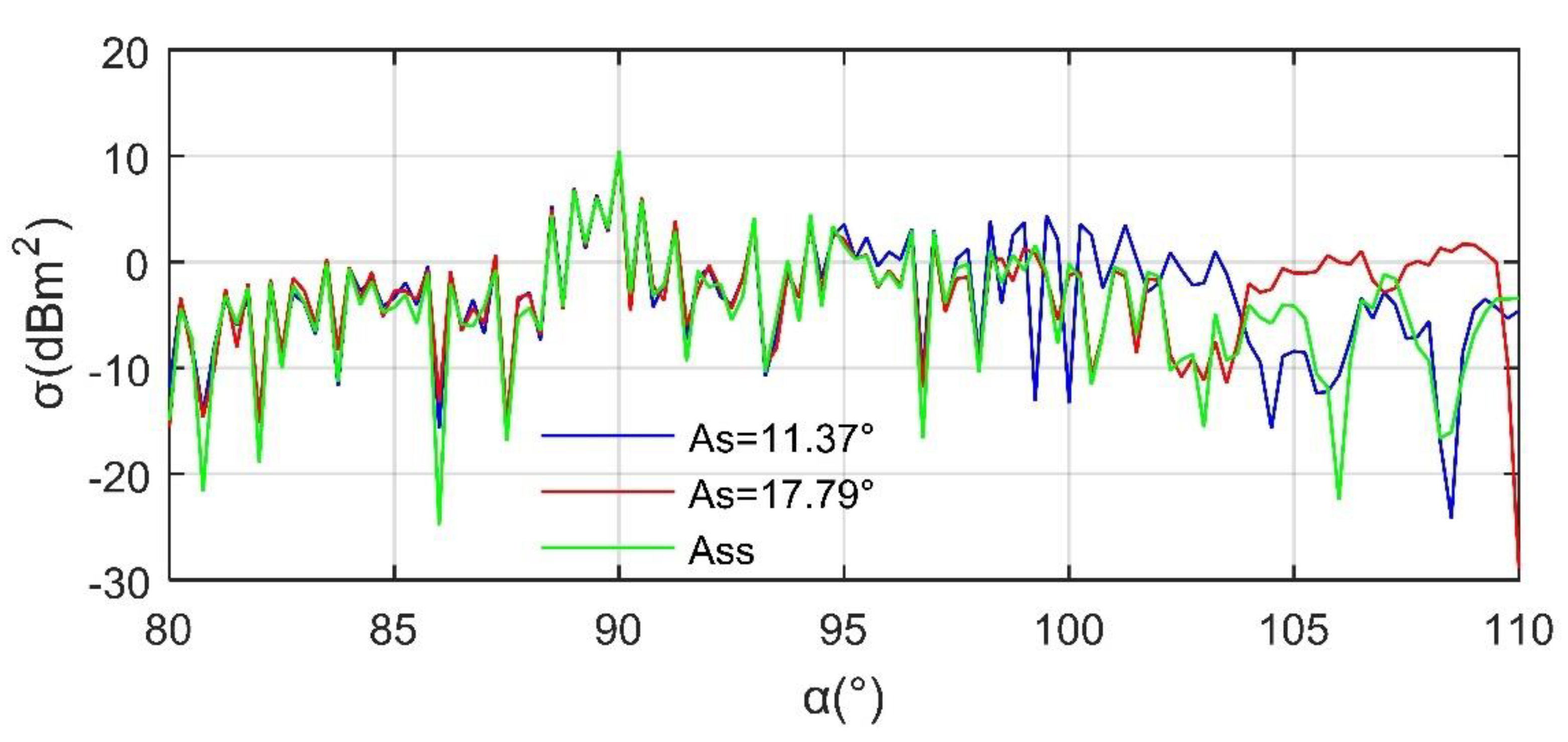
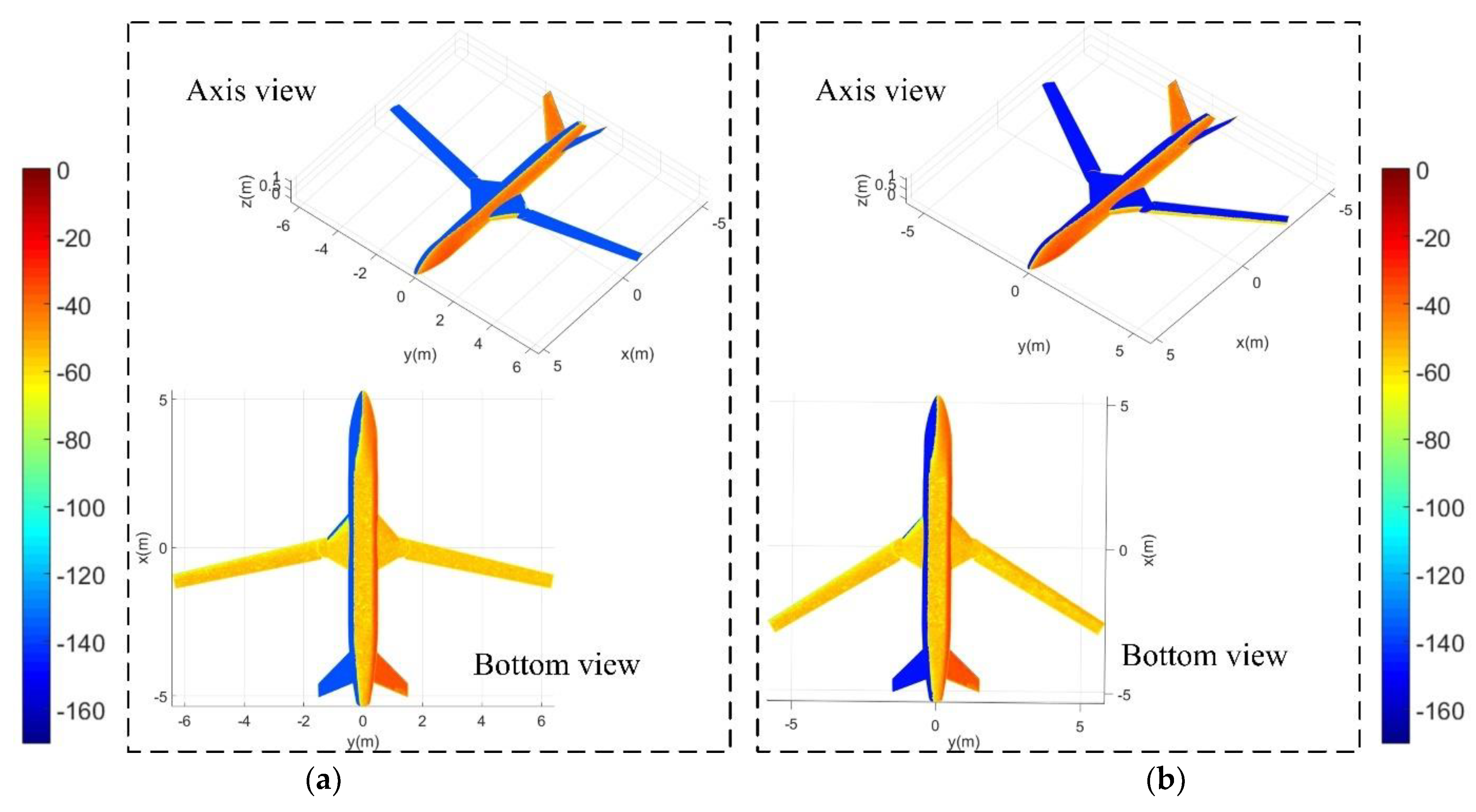
| Parameter | Lf (m) | Yw2 (m) | Wf1 (m) | Hv (m) | Wf2 (m) |
|---|---|---|---|---|---|
| Value | 10.641 | 1.2 | 1.02 | 1.108 | 3.1 |
| Parameter | Lw (m) | Cw1 (m) | Yw1 (m) | Rw1 (m) | Lte (m) |
|---|---|---|---|---|---|
| Value | 5.3 | 0.49 | 1.2 | 0.35 | 5.006 |
| Region | Limit (mm) | Region | Limit (mm) |
|---|---|---|---|
| Global minimum | 1 | Wing trailing edge | 2 |
| V-tail trailing edge | 2 | Wing tip edge | 3 |
| V-tail leading edge | 3 | Wing leading edge | 3 |
| Fuselage edge | 5 | Wing surface | 35 |
| V-tail surface | 35 | Fuselage surface | 35 |
| Frh (GHz) | 3 | 4 | 5 | 6 | 7 |
| Mean (dBm2) | −9.3433 | −8.9249 | −8.4286 | −8.0077 | −7.5518 |
| β (°) | 0 | 3 | 5 | 7 | 9 |
| Mean (dBm2) | −12.2337 | −12.0511 | −11.9652 | −11.9023 | −11.8431 |
Publisher’s Note: MDPI stays neutral with regard to jurisdictional claims in published maps and institutional affiliations. |
© 2022 by the authors. Licensee MDPI, Basel, Switzerland. This article is an open access article distributed under the terms and conditions of the Creative Commons Attribution (CC BY) license (https://creativecommons.org/licenses/by/4.0/).
Share and Cite
Zhou, Z.; Huang, J. Auto Sweptback Wing Based on Low Scattering Demand for an Unmanned Aerial Vehicle in Phase Flight. Aerospace 2022, 9, 757. https://doi.org/10.3390/aerospace9120757
Zhou Z, Huang J. Auto Sweptback Wing Based on Low Scattering Demand for an Unmanned Aerial Vehicle in Phase Flight. Aerospace. 2022; 9(12):757. https://doi.org/10.3390/aerospace9120757
Chicago/Turabian StyleZhou, Zeyang, and Jun Huang. 2022. "Auto Sweptback Wing Based on Low Scattering Demand for an Unmanned Aerial Vehicle in Phase Flight" Aerospace 9, no. 12: 757. https://doi.org/10.3390/aerospace9120757
APA StyleZhou, Z., & Huang, J. (2022). Auto Sweptback Wing Based on Low Scattering Demand for an Unmanned Aerial Vehicle in Phase Flight. Aerospace, 9(12), 757. https://doi.org/10.3390/aerospace9120757







